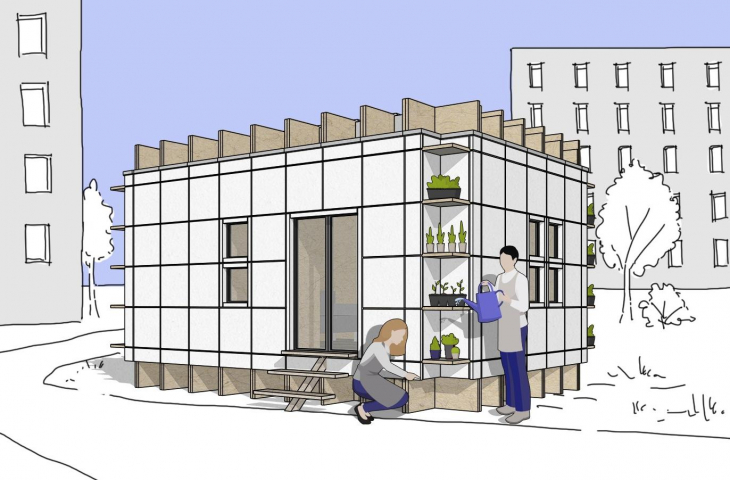The{tag:studenci} from Warsaw University of Technology received an honorable mention in the international MICROHOME 2020 competition organized by the Bee Breeders platform. The task was to design a modular building in the trend of sustainable architecture, with an area of no more than 25 square meters!
MICROHOME is an annual architectural competition organized as part of the Bee Breeders Small-Scale Architecture competition series and in cooperation with ARCHHIVE BOOKS publishing house. MICROHOME aims to highlight the importance that small-scale architecture can have in the face of the housing, economic and climate crisis.
The structure of the house is made of EcoBoards
© Zuzanna Słabik
innovative projects on a small scale
The task the organizers set for the participants was to design a modular structure in the sustainable architecture trend, with an area of no more than 25 square meters, which would be suitable for a pair of young professionals. The design had to include a kitchen, a bedroom, a bathroom, a space for work and relaxation, as well as storage space.
Even the smallest designs can contain big ideas. The proposals submitted to the competition sometimes generate ideas that can later be expanded into larger-scale projects. They act not only as a testing ground for geometric, material and structural issues, but are also invaluable for testing at the conceptual level," stressed Ben van Berkel of UN Studio.
The entries submitted for the competition were evaluated by an international jury consisting of: Oke Hauser (vice president of Architecture and Design at Quarters Co-Living in Berlin and former creative director and project manager of BMW-MINI Living), Brian Gaudio (CEO of Module Housing, based inPittsburgh), Anne Cecilie Haug (architect at Snøhetta, Oslo), Carlo Ratti (director of the MIT SENSEable City Lab and Carlo Ratti Associati, based in Milan), and Patrik Schumacher (director of Zaha Hadid Architects in London).
There are storage spaces in the walls and floor
© Zuzanna Słabik
honorable mention for polish student
Among the submitted works, the competition jury singled out the Modular House Unit project made by Zuzanna Słabik, a final-year architecture student at the Warsaw University of Technology. Referring to the competition guidelines, the author paid special attention to the creation of space for work, rest and storage.
My project is a response to the problems of modern users, especially young couples. These are people who work mainly from home during the pandemic, while they do not have enough capital to buy their own place. By working remotely, they do not need to be tied to a place and can work from any location in the world. The main idea was to create a building that would function like an IKEA piece of furniture," says Zuzanna Slabik.
The author wanted to create a design that would function like a piece of furniture from Ikea
© Zuzanna Słabik
The architect's proposed folding modular house, which could be ordered online, offers many design possibilities. Thanks to the thoughtful dimensions of the elements (the weight of a single element does not exceed 50 kg), the house can be assembled by two people using basic tools. It is also possible to use the facility on a recurring basis - renting the house and returning it after use.
Such a way seems ideal during a pandemic. We rent the house for a few months for remote work, and then return it. It is sanitized and rented out to the next users. The cost of building such a house is about €7,000," the author adds.
Eco-friendly folding modular house
Thanks to modularity, it is easy to enlarge the structure of the house or add elements such as a terrace. In the project, the author has provided for several variants of the plan. All the elements for the construction of the house fit in one van and can be installed on any flat surface of about 6×4 meters. The grid structure provides stability and an interesting spatial solution with plenty of storage space, for which the thickness of the wall and floor were used.
Theecological nature of the project is not only economic aspects, but also material solutions. EcoBoards, from which the house is made, is a material with a negative carbon footprint. The boards, made from agricultural fibers derived from grain processing, have high structural strength and better water resistance than wood-based materials. Importantly, they do not contain formaldehyde glue, meaning they do not emit toxic fumes.
A folding modular house can be built anywhere
© Zuzanna Słabik
The facades and roofing were made from scraps of sheet metal recovered from construction sites, for example. As insulation, the author suggested mineral wool derived from natural magma rock and slag (a by-product of steel production). The architect also used such solutions as solar panels, electric batteries, rainwater collection and filtration, and her own composter. The use of many recycled elements makes the house completely eco-friendly.






































